1. Will I Have a Snow Day Tomorrow?
The thrill of a possible snow day creates a shared buzz among kids hoping for a day off, parents planning around potential disruptions, and teachers monitoring school closure updates. The question “Will I have a snow day tomorrow?” drives countless searches as people seek clarity on weather-driven school cancellations. This post explores the tools, weather predictions, and practical tips to help you answer this question.
2. What Factors Decide a Snow Day?
Wondering, “Will I have a snow day tomorrow?” Several key factors determine whether schools close for a snow day, driven by weather and safety considerations. Understanding these factors lets you better predict closures and get ready. Here’s a breakdown of the main factors influencing snow day decisions, optimized for SEO with the keyword Will I have a snow day tomorrow?
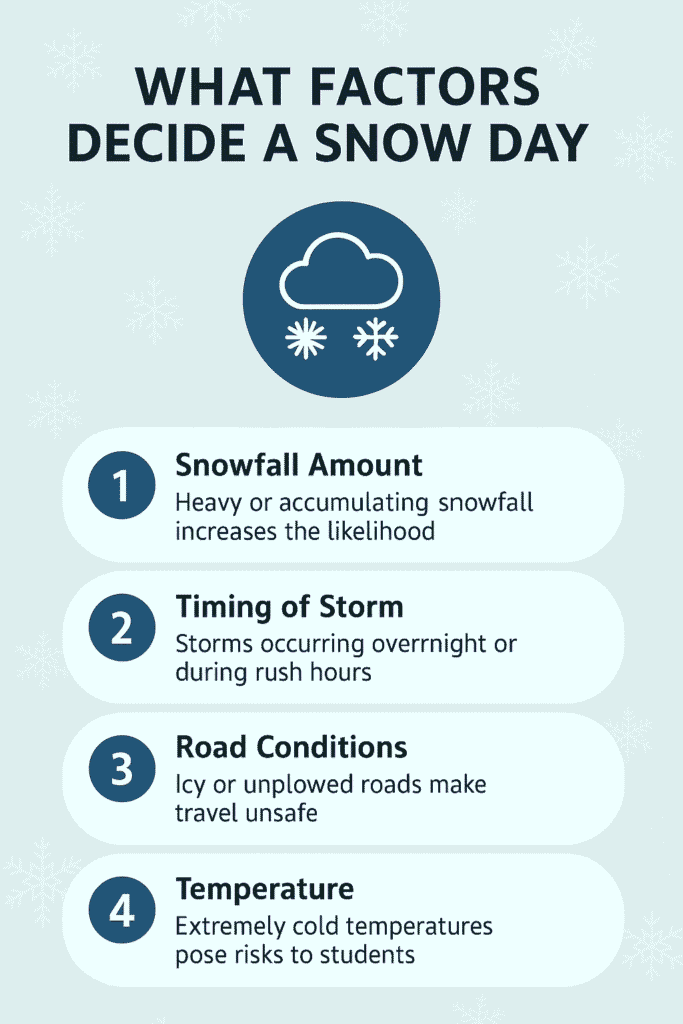
- Weather Conditions
Heavy snowfall, ice accumulation, and extreme wind chill are primary triggers for school closures. Significant snow or icy conditions make travel hazardous, prompting districts to prioritize safety. When searching “Will I have a snow day tomorrow?” check local forecasts for snow totals, ice risks, and wind chill advisories to gauge closure likelihood. - Road and Travel Safety
Snow-covered or icy roads pose risks for buses, staff, and student drivers. School districts assess road conditions through local authorities and transportation teams. If travel safety is compromised, a snow day is more likely. Monitoring road updates can help answer, “Will I have a snow day tomorrow?” - School District Policies
Each district has unique guidelines for snow days, factoring in local climate, infrastructure, and past weather events. Some districts close based on specific snowfall thresholds (e.g., 4+ inches), while others consider regional impacts. Check your district’s website or social media for closure policies to better predict, “Will I have a snow day tomorrow?” - Timing of the Storm
The storm’s timing is critical. Overnight storms allow districts to assess conditions early, often leading to morning closure announcements. Mid-day storms may result in early dismissals or next-day closures if conditions worsen. When asking, “Will I have a snow day tomorrow?” track storm timing via weather apps for accurate predictions.
By understanding these factors—weather conditions, road safety, district policies, and storm timing—you can better anticipate school closures. Use tools like weather apps, district alerts, and snow day calculators to stay informed and answer, “Will I have a snow day tomorrow?” with confidence.
3. Tools That Predict If You’ll Have a Snow Day
Wondering if a snowstorm will lead to a snow day? Several tools can help predict school closures based on weather forecasts and local data. From user-friendly calculators to AI-powered predictors and official school alerts, here’s a breakdown of the best tools to check for snow day prediction, including how they work, their accuracy, limitations, and where to find them.
a. Snow Day Calculator: Your Go-To for Snow Day Odds
The Snow Day Calculator is a popular tool for students, parents, and teachers eager to predict the likelihood of a school closure due to snow.
How It Works:
- Inputs: Enter your zip code, expected snowfall amount, school start time, and sometimes additional details like local weather conditions or school district policies.
- Calculation: The tool uses historical weather data, regional snow trends, and school closure patterns to estimate the probability of a snow day (e.g., “75% chance of a snow day”).
- Output: You receive a percentage-based prediction, often with a fun, user-friendly interface.
Accuracy and Limitations:
- Accuracy: The Snow Day Calculator is fairly reliable for general predictions, especially in areas with consistent snow patterns. It leverages historical data and basic weather forecasts to provide a solid estimate.
- Limitations:
- Relies on user-provided data, which may not always be accurate (e.g., incorrect snowfall estimates).
- Lacks real-time weather updates, so last-minute changes in forecasts can reduce accuracy.
- May not account for hyper-local factors like road conditions or specific school district policies.
- Best for preliminary planning rather than definitive answers.
Why Use It? The Snow Day Calculator is fast, simple, and useful for a rough prediction. Access it online via websites like thesnowdaycalculator.xyz for instant predictions.
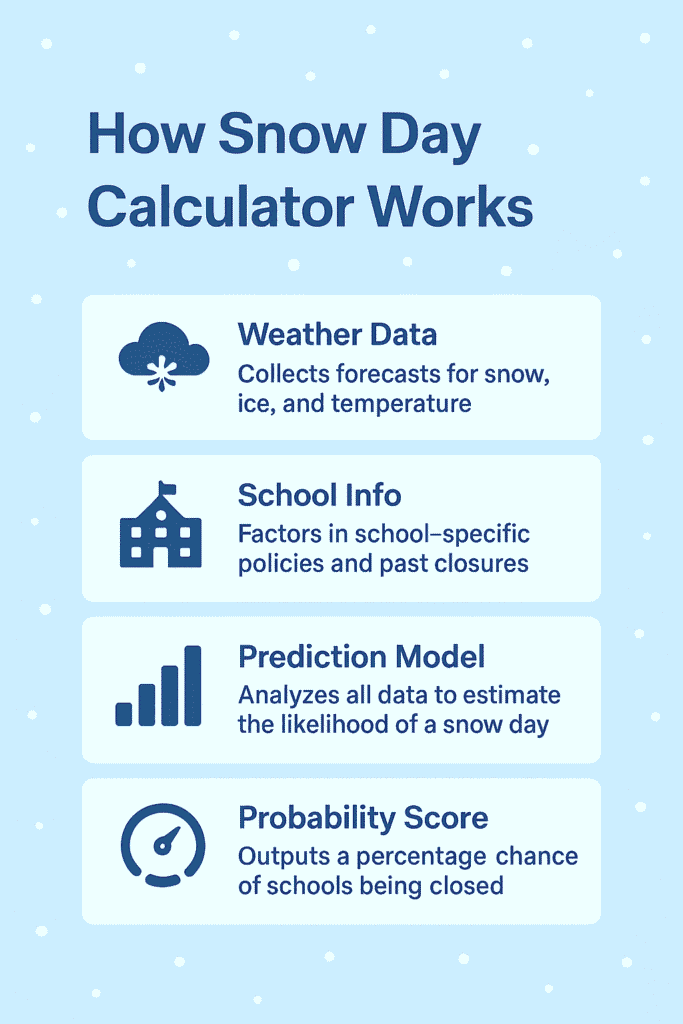
b. Snow Day Predictor: AI-Powered Precision
The Snow Day Predictor is a modern competitor that uses advanced technology to deliver highly accurate snow day forecasts, especially for hyper-local areas.
How It Works:
- Technology: Combines AI algorithms with real-time weather data from sources like NOAA or local weather stations.
- Inputs: Typically requires a zip code or city name, but some versions automatically pull location data from your device.
- Analysis: The AI analyzes current snowfall, temperature, wind speeds, and even social media chatter about local road conditions to predict school closures.
- Output: Provides a detailed probability score and sometimes additional insights (e.g., “90% chance of closure due to heavy snow and icy roads”).
Accuracy and Limitations:
- Accuracy: Stronger than traditional calculators due to its use of real-time data and AI. It excels in hyper-local predictions, making it ideal for specific neighborhoods or small school districts.
- Limitations:
- May require a subscription or premium access for full features.
- Accuracy depends on the quality of real-time data, which can vary in rural areas.
- Less effective if school closure decisions deviate from weather-based logic (e.g., due to staffing issues).
Why Use It? Snow Day Predictor is perfect for those seeking cutting-edge, location-specific forecasts. Check platforms like snowdaypredictor.com or weather apps with AI-driven snow day features.
c. Official School Alerts: The Most Reliable Source
When it comes to definitive snow day announcements, official school alerts from your school district are the gold standard.
How It Works:
- Source: School districts monitor weather forecasts, road conditions, and safety concerns to make closure decisions.
- Delivery: Alerts are sent via:
- District websites: Check the homepage or “Announcements” section.
- Robocalls or text messages: Automated systems notify parents and students.
- Mobile apps: Many districts use apps like SchoolMessenger or Remind for instant updates.
- Email blasts: Sent to registered parents and staff.
- Social media: Follow your district’s X, Facebook, or Instagram for real-time posts.
Accuracy and Limitations:
- Accuracy: 100% reliable since these alerts come directly from the decision-makers. If the district announces a snow day, it’s official.
- Limitations:
- Timing: Alerts may not arrive early enough for planning (e.g., late-night or early-morning announcements).
- Can be inconvenient if you miss the notification (e.g., no phone access).
- Requires proactive checking if your district’s communication system isn’t robust.
Where to Find Them:
- Visit your school district’s website for closure updates.
- Sign up for **robocalls or Ascertain whether your district uses automated calls, texts, or emails.
- Download your district’s mobile app (e.g., SchoolMessenger, Remind) for push notifications.
Why Use It? Official alerts are the most trustworthy source for snow day confirmations. Set up notifications to stay informed without delay.
4. How to Check Your Chances of a Snow Day Tomorrow
To check your chances of a snow day tomorrow, follow these step-by-step methods to gather accurate information and make an informed prediction:
Use a Snow Day Calculator:
- Visit a snow day calculator website, such as SnowDayCalculator.com or similar platforms.
- Input required details, including your ZIP code, the date (tomorrow’s date), and sometimes additional factors like school district or historical snow day data.
- The calculator analyzes weather data, past trends, and school closure history to estimate the likelihood of a snow day as a percentage.
- Review the results, which typically provide a probability (e.g., 70% chance) and may include a brief explanation of contributing factors like snowfall amount or temperature.
Check Weather Forecasts:
- Visit trusted weather sources like NOAA (weather.gov) or AccuWeather (accuweather.com).
- Enter your location to access tomorrow’s forecast, focusing on:
- Snow accumulation: More than 2-3 inches often increases snow day chances.
- Timing: Snowfall overnight or during early morning hours is more likely to disrupt school.
- Temperature and conditions: Freezing temperatures, ice, or high winds can amplify closure likelihood.
- Cross-reference multiple sources for consistency, as forecasts can vary slightly.
Monitor Your School District’s Communication Channels:
- Check your school district’s official website, email notifications, or automated phone systems for closure announcements or weather-related updates.
- Sign up for alerts if available, as many districts send texts or emails about closures.
- Look for updates in the evening or early morning, as decisions are often made when forecasts solidify.
Use Social Media for Updates:
- Follow your school district’s official accounts on platforms like Twitter/X or Facebook for real-time closure announcements.
- Search for local hashtags (e.g., #YourCitySnow or #SchoolClosures) to see community discussions or unofficial updates.
- Monitor local news outlets or meteorologists on social media for breaking weather updates that could influence school decisions.
5. Can I Trust a Snow Day Prediction?
Snow day predictions, while useful, should be treated as a guide rather than a guarantee due to the inherent uncertainties in weather forecasting and school decision-making processes. Here’s why and how to approach them:
a. Why Snow Day Predictions Are Not Guaranteed:
- Dynamic Updates: Weather forecasts and school decisions evolve, especially in the hours leading up to a potential snow day. A prediction made 24 hours in advance might not reflect last-minute changes.
- Weather Forecast Uncertainty: Snow day prediction, such as those from calculators or apps, rely on weather models (e.g., NOAA or AccuWeather). These models can be accurate but are not foolproof, as weather conditions like snowfall timing, intensity, or ice formation can change unexpectedly. For example, a predicted 6-inch snowfall might only be 2 inches, reducing closure likelihood.
- School District Discretion: Schools consider factors beyond weather, such as road safety, staffing, and local policies. A district might stay open despite heavy snow if roads are cleared or close with light snow due to icy conditions or prior cancellations. Predictions can’t fully account for these subjective decisions.
- Regional Variations: Snow day calculators often use general data (e.g., ZIP code-based forecasts) and may not reflect microclimates or specific district thresholds for closures, leading to inaccuracies.
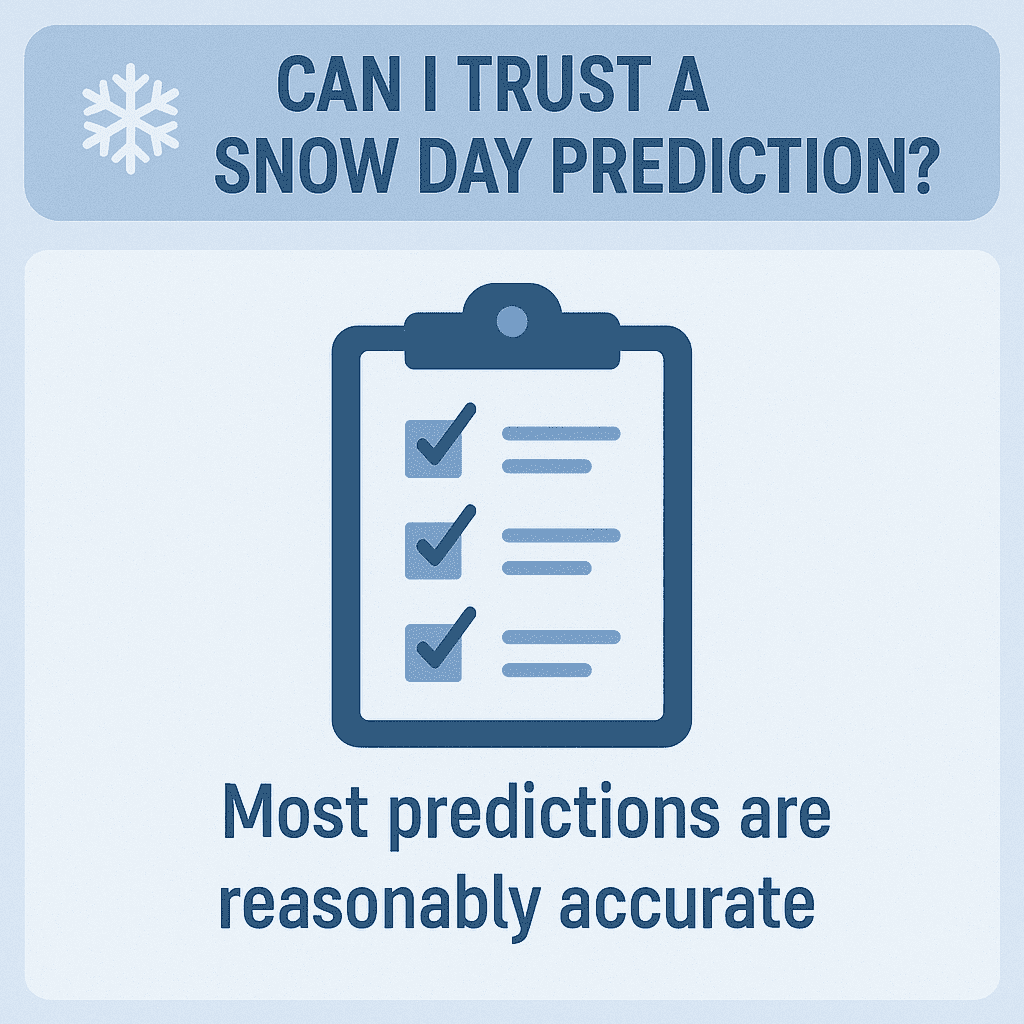
b. Treat Predictions as a Guide:
- Use predictions to prepare—e.g., plan for possible remote learning or transportation changes—but don’t rely on them exclusively for decisions like cancelling plans or assuming no school.
- Snow day predictions, like those from SnowDayCalculator.com, provide a helpful probability (e.g., 80% chance) based on weather data, historical closure trends, and sometimes user inputs. They’re a starting point to gauge likelihood but shouldn’t be taken as definitive.
c. Always Double-Check with School/District Communications:
- Why It’s Critical: Even if a calculator predicts a high chance of a snow day, schools may opt for remote learning, delayed openings, or no closure. Official communications clarify these outcomes.
- Official Channels Are Authoritative: The only definitive source for snow day confirmations is your school or district’s official communications, such as their website, email alerts, automated phone calls, or text notifications. These reflect actual closure decisions, not estimates.
How to Check:
- Monitor the district’s website or app for closure announcements, typically updated the evening before or early morning (e.g., 5–6 AM).
- Sign up for district alerts to receive real-time texts or emails.
6. Tips to Prepare for a Possible Snow Day
- Backup Plan for Childcare/Work: Arrange alternative childcare or work-from-home options in case schools or workplaces close.
- Charge Devices, Prep Indoor Activities: Ensure devices are fully charged and have games, books, or crafts ready to keep everyone occupied indoors.
- Stay Informed: Use weather apps and official alerts to track snowstorm updates and closure announcements.
7. FAQs: Will I Have a Snow Day Tomorrow?
a. How Early Do Schools Announce Closures?:
Schools typically notify families the night before or early morning of a snow day, depending on weather forecasts and district policies.
b. Can Snow Day Apps Predict Accurately?:
Apps provide estimates based on weather data, but they’re not always accurate due to variable local conditions and school decisions.
c. What If My Friends’ Schools Are Closed but Mine Isn’t?:
School districts have different closure criteria, so your school may remain open based on its specific location, road safety, or policies.
d. Why Did My School Stay Open When It Snowed Heavily?:
Schools may stay open if roads are deemed safe, staffing is adequate, or the district prioritizes instructional time, despite heavy snow.
8. Conclusion
- Use a combination of tools (e.g., snow day calculators), real-time weather data, and official alerts from schools or local authorities to stay prepared.
- Avoid depending solely on predictive apps or forecasts, as they can be unreliable.
- Snow day tools are useful for fun and preliminary planning but should not be treated as definitive sources for closure confirmation.
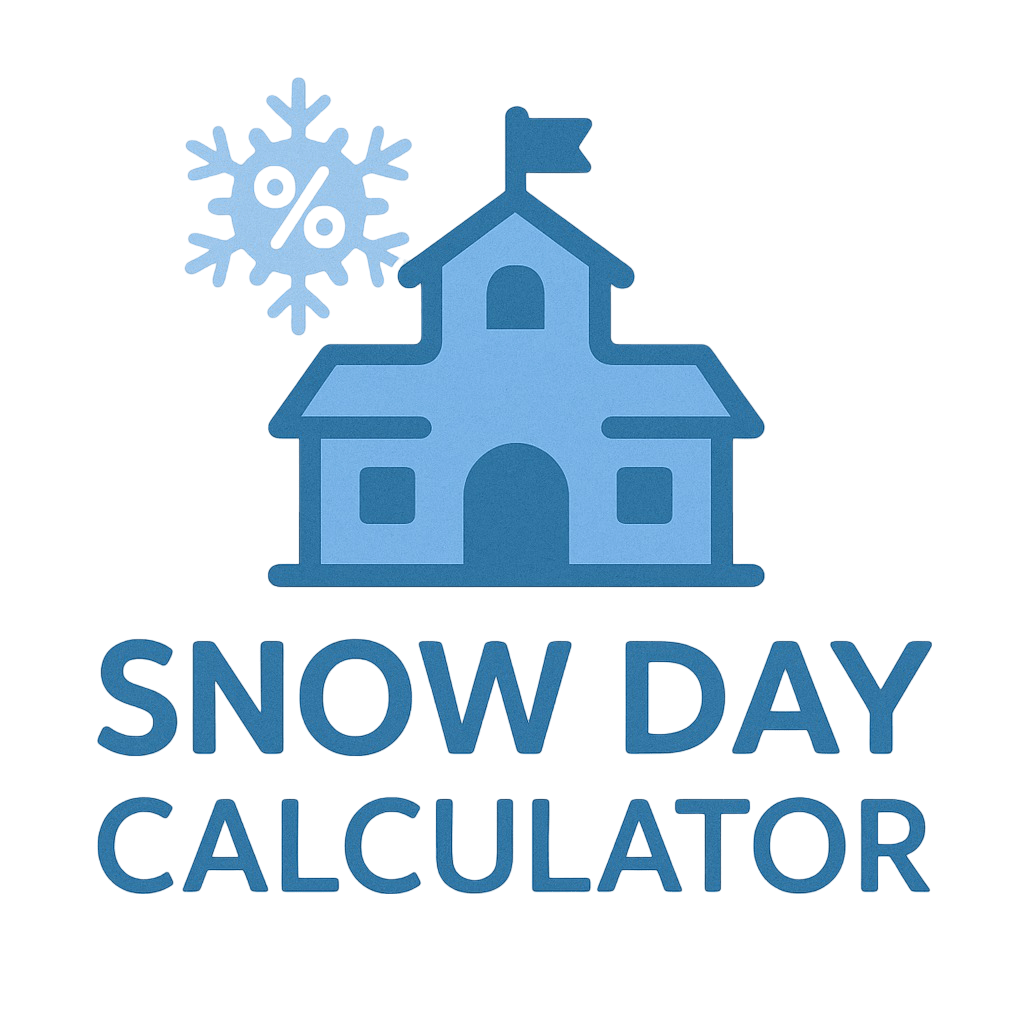
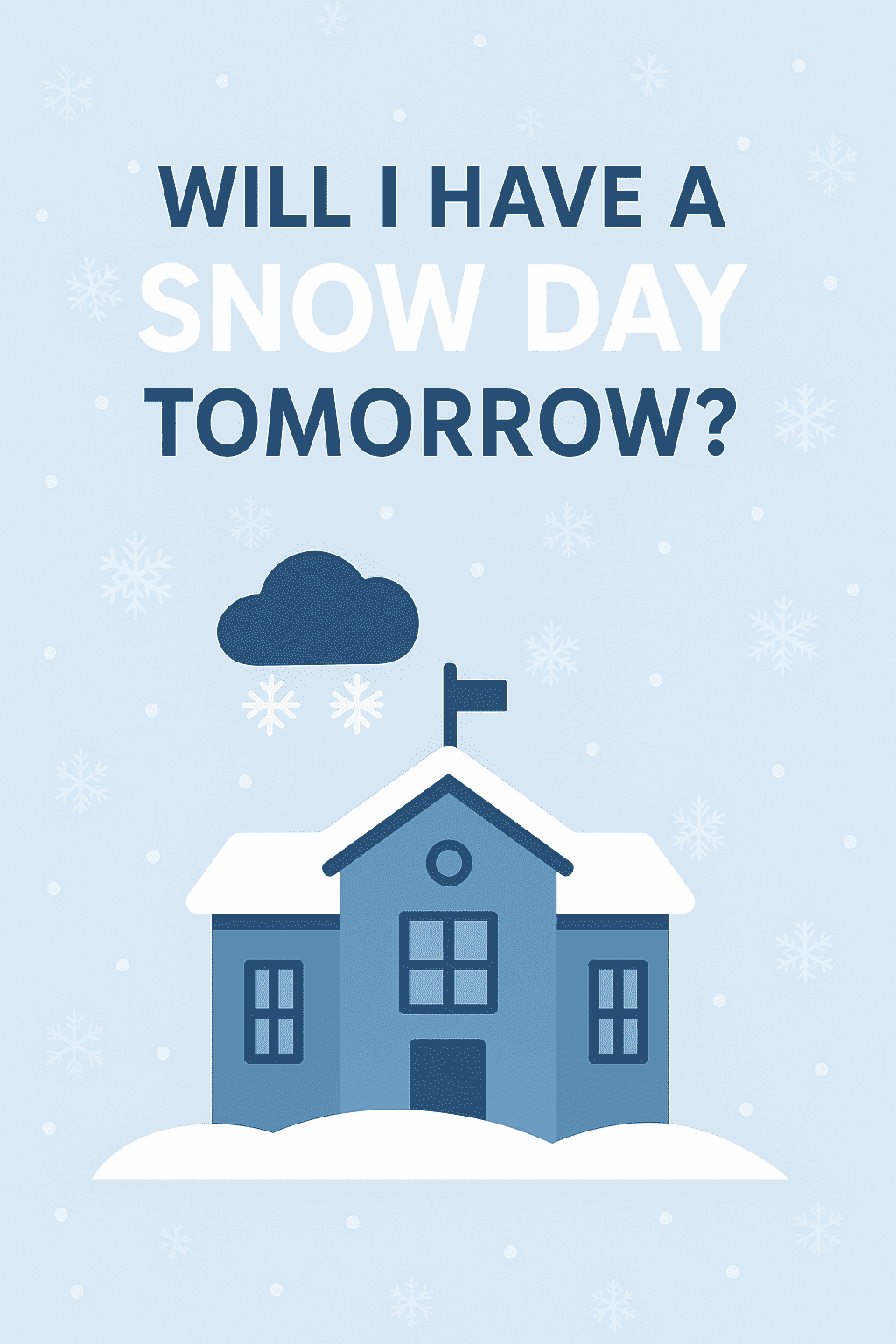
4 thoughts on “Will I Have a Snow Day Tomorrow? Accurate Snow Day Prediction Near You”